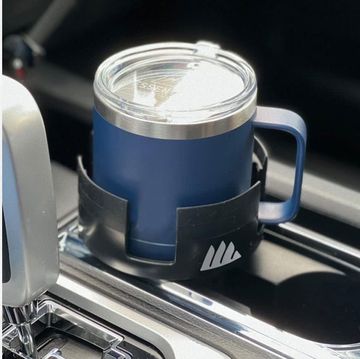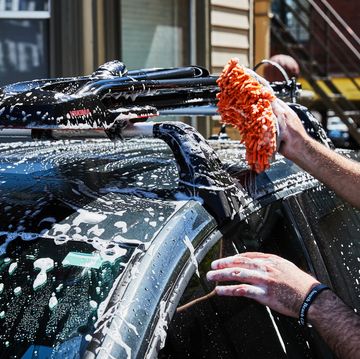Adhesive vinyl can look as good as new paint, at far less cost.
1
Media Platforms Design Team
How to Vinyl-Wrap a Car

If you've ever tried to apply numbers to a club racing or weekend autocross car, chances are you've dealt with trapped air bubbles and crooked results. But today's top-adhesive-vinyl technology is much more advanced, allowing pros and DIY detailers alike to get great-looking results.
Modern adhesive reaches its most sticky state after 24 hours, making it repositionable. The vinyl itself, a highly formable "cast" vinyl, has channels to allow air to escape, eliminating bubbles. A factory laminate coating can make the vinyl wrap last up to 10 years. Finally, vinyl called supercast can stretch up to 40 percent, so it can be molded around curves and sharp bumper edges.
Cast-vinyl wrapping began mostly as a way to display advertising on cars, but a growing trend is to use solid colors as a replacement for painting an entire car, says Molly Waters, a specialist for Avery Dennison Graphics Solutions in Dallas. To watch the process in action, we traveled to Graphik Concepts in suburban Detroit and watched vinyl-wrap experts Gordon Nodacker, Chris Lokker, and Mike Allen wrap a plain white Ford Transit Connect for a local caterer with repositionable vinyl printed in-house. The whole job took about 10 hours, and these guys are good: They've even done huge graphics on the Goodyear blimp, as well as special concept cars for automakers. Here's how vinyl is applied and (eventually) removed:
Modern adhesive reaches its most sticky state after 24 hours, making it repositionable. The vinyl itself, a highly formable "cast" vinyl, has channels to allow air to escape, eliminating bubbles. A factory laminate coating can make the vinyl wrap last up to 10 years. Finally, vinyl called supercast can stretch up to 40 percent, so it can be molded around curves and sharp bumper edges.
Cast-vinyl wrapping began mostly as a way to display advertising on cars, but a growing trend is to use solid colors as a replacement for painting an entire car, says Molly Waters, a specialist for Avery Dennison Graphics Solutions in Dallas. To watch the process in action, we traveled to Graphik Concepts in suburban Detroit and watched vinyl-wrap experts Gordon Nodacker, Chris Lokker, and Mike Allen wrap a plain white Ford Transit Connect for a local caterer with repositionable vinyl printed in-house. The whole job took about 10 hours, and these guys are good: They've even done huge graphics on the Goodyear blimp, as well as special concept cars for automakers. Here's how vinyl is applied and (eventually) removed:
2
Media Platforms Design Team
Choose the Vinyl

Usually the vinyl is sold in 60-inch-wide rolls measuring 25 feet long, which is about how much it takes to wrap a whole car. That much will sell for around $2500-less if there are no graphic elements such as stripes, marketing slogans, or images. That doesn't include labor, which is 6 to 8 hours to wrap a typical car, and rates vary widely in different markets. Prices also vary depending upon how difficult it is to wrap a particular car. Something like a Chrysler PT Cruiser with lot of curved sheet metal will take longer and cost a little more than more linear auto.
3
Media Platforms Design Team
Prep the Paint

Start with a thorough cleaning with paint cleaners and alcohol. Then fix up scratches, dings, and rust. "Working with vinyl is a lot like repainting," Waters says. "If you can feel it, it will show up. A dead bug on the paint will look like a crater under vinyl."
Waters has noticed an increase in customers whose businesses require special paint colors, such as Mary Kay cosmetics' famous pink, as well as with those who want to try out a wild new color. Graphik Concepts' Chris Lokker says one of his customers had a new bright orange Lamborghini but wrapped it in bright lime green vinyl because he thought there were too many orange Lamborghinis out there. All of these customers reported an intention to remove their wild-colored vinyl when sell their cars, hoping that there will be more of a market for the cars with their original paint-which, incidentally, is likely to be in top condition because the vinyl wrap can protect paint from scratches, rock chips, and fading from the sun.
Waters has noticed an increase in customers whose businesses require special paint colors, such as Mary Kay cosmetics' famous pink, as well as with those who want to try out a wild new color. Graphik Concepts' Chris Lokker says one of his customers had a new bright orange Lamborghini but wrapped it in bright lime green vinyl because he thought there were too many orange Lamborghinis out there. All of these customers reported an intention to remove their wild-colored vinyl when sell their cars, hoping that there will be more of a market for the cars with their original paint-which, incidentally, is likely to be in top condition because the vinyl wrap can protect paint from scratches, rock chips, and fading from the sun.
Advertisement - Continue Reading Below
4
Media Platforms Design Team
Remove Mirrors and Molding

You can cut down the labor time for wrapping if you remove the car's body parts such as mirrors and molding first. "It might take you 30 minutes to work the vinyl around a mirror," Waters says. "It might only take 5 minutes to remove the mirror."
5
Media Platforms Design Team
Plan the Process

Professional car wrappers will begin the process in different ways, depending on the car. "The hardest parts are the bumpers, so sometimes I like to start with them to get them done," Waters says. "Or I'll start with the hood, then move to the roof. You have to look at the vehicle and see where the breaks in the lines are [to avoid creating seams]." The installer will use a utility knife to cut the vinyl into sections that will cover individual body panels. They then tape it on or use magnets to hold it in place while they remove the vinyl's backing paper to expose the adhesive.
6
Media Platforms Design Team
Stick It On

Once the adhesive is exposed, stick the vinyl onto the center of the body panel, or start on one side. It can be smoothed out with your hands, or a plastic or Teflon squeegee. During this process you can stretch the vinyl to fit over curves or reposition it. Just be careful how you smooth the vinyl so you avoid kinks or ridges. "If the hood's flat, go top to bottom," Waters says. "If it's bowed, like a VW Bug, you have to work with the squeegee in an arc shape to prevent little wrinkles that look like bottle-cap edges."
Advertisement - Continue Reading Below
7
Media Platforms Design Team
Stretch It Out

"Once you work with vinyl a little bit, you can figure out how to stretch it and to let it shrink back," Waters says. Some installers use heat guns to encourage the vinyl to stretch. Some even use a torch, but it takes practice not to burn the vinyl. Prestretching the vinyl can help it shrink into concave panels such as bumpers.
8
Media Platforms Design Team
Cut Off the Edges

Once the vinyl has adhered to the car, cut off the edges with a utility knife. Waters uses the small kind with breakaway blades. "Really good installers can trim the vinyl with a knife right on the paint and not cut the paint," she adds. Normally, however, you cut the vinyl and then reapply the edges.
9
Media Platforms Design Team
Deal With Seams

Sometimes seams are unavoidable, like when you wrap surfaces such as big trucks or Viper hoods that are wider than 60 inches. Some installers will overlap sheets of vinyl and cut a seam with a knife. Others will overlap a seam with the edge facing away from the line of sight of the car. A product called knifeless tape applies a filament thread made of thin Kevlar to the car body under the vinyl. After the vinyl sheet has adhered to the car body over the thread, the thread is sharp enough that it can be pulled through the vinyl, cutting it precisely. Other installers use pinstriping to hide seams. Waters says that when the job's done right, the seam disappears: "I've had to go up and touch a car to find a seam."
Advertisement - Continue Reading Below
10
Media Platforms Design Team
Removal

Modern cast-vinyl wraps are long-term removable, which means the adhesive is not designed to be permanent. The color and laminate coatings are also designed to last for 10 years, which means at some point they need to be removed. "It's still not fun to remove any vinyl wrap," Waters says. There are citrus-based chemicals that will dissolve the adhesive (Waters uses Goo Gone). "Today's vinyl, when you heat it up, leaves very little adhesive behind," she says.
Watch Next

Advertisement - Continue Reading Below

The Best Car Cup Holder Adapters in 2024

Presented by Castrol
How To Wash Your Car

Presented by Castrol
The Best Car Tools to Keep Up With Maintenance

Presented by Castrol
How to Replace Your Car’s Brakes
Advertisement - Continue Reading Below
Advertisement - Continue Reading Below







